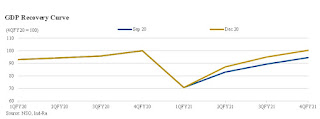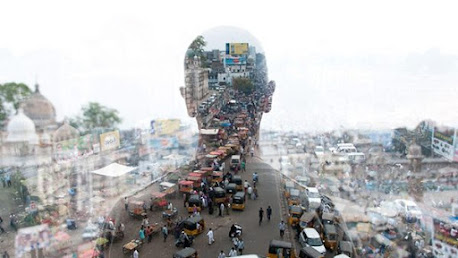GDP India Expectation FY21Revised: Ind-Ra
Revised to negative 7.8% from negative
11.8% due to the easing of headwinds!
India Ratings and Research (Ind-Ra) has revised its expectation for India’s FY21 gross domestic product (GDP) growth to negative 7.8% from negative 11.8% due to the easing of the Covid-19 headwinds and better-than-expected 2QFY21 GDP numbers. However, the question remains, how sustainable is the recovery witnessed in 2QFY21, as a significant part of the impetus came from the festival and pent-up demand.
Although
the headwinds emanating from Covid-19 related challenges are unlikely to go
away till mass vaccination becomes a reality, perhaps the economic agents and
economic activities not only have learnt to live with it but also are adjusting
swiftly to the post Covid-19 world. Ind-Ra now expects 3QFY21 GDP growth to
come in at negative 0.8% and 4QFY21 GDP growth to turn positive at 0.3% as
against its earlier expectation it turning positive in 4QFY22. The agency expects
FY22 growth to be 9.6%, mainly due to the favourable/weak base of FY21.
The non-contact intensive sector such as manufacturing/electricity and other utilities in 2QFY21 recorded positive growth, and the mining and construction sectors saw significant reduction in negative growth.
However, the same is not true for the contact-intensive services sectors such as trade, hotel, real estate, and tourism and they are likely to remain subdued for some more time due to social distancing norms and risk aversion.
Agriculture has been a bright spot even through the Covid-19 related lockdown and continues to be so, riding on the back of the favourable 2020 monsoon.
Ind-Ra therefore expects agriculture, industry and services to grow at 3.5%, negative 10.3% and negative 9.8% YoY, respectively, in FY21.
Private consumption, which has been the mainstay of aggregate demand, came under significant pressure in FY20 which got aggravated in FY21 due to Covid-19 headwinds. Although rural demand, on the back of four consecutive good harvests, is lending support to the consumption demand, it is inadequate to compensate for the loss of urban demand.
Urban demand, despite gaining some momentum lately, may remain subdued due to the depressed consumer sentiment and lower economic activity/employment generation. On the other hand, monetary and fiscal measures, although have eased the liquidity requirements and are supportive of consumption, may still not be sufficient to spur investments as capacity utilisation has not yet fully recovered even to the pre-Covid level. Ind-Ra expects private final consumption expenditure and gross fixed capital formation to fall 13.4% and 16.8% YoY, respectively, in FY21.
Of the other two demand-side growth drivers, while government expenditure is expected to grow at just 3.3% YoY due to significant expenditure compression, exports could fall 7.9% YoY in FY21 due to a combination of the ongoing trade conflict and Covid-19 pandemic, increasing the uncertainty in the global economy. Government expenditure declined by 22.2% YoY and gross value-added of public administration and defence declined by12.2% YoY in 2QFY21.
Food
and crude oil prices are the two key factors that drive inflation in the Indian
context. Although international crude prices are benign and likely to remain so
during the remainder FY21, its benefit did not percolate to the domestic
economy, as the government raised excise duty on petrol and diesel to garner
additional revenue.
On the other hand, due to supply-side disruptions and seasonal sensitivities of certain fruits and vegetables, the food inflation and thus retail inflation has remained elevated.
The significant divergence between the retail and wholesale inflation clearly indicates that supply-side glitches and large margins, which were witnessed during the countrywide lockdown, have not normalised.
Even retail core inflation has inched up and is hovering at 5.0% - 5.8% since May 2020, indicating cost-push pressures. Ind-Ra thus expects retail and wholesale inflation to average 6.8% and negative 0.3% in FY21.
Ind-Ra believes this will provide very little headroom to the Reserve Bank of India in the near term to make any changes in the policy rates, and it may continue with the accommodative policy stance. As a result, 10-year G-sec bond yield is expected to trade in the range of 6.0%-6.1% by FYE21.
The FY21 fiscal deficit of the Union Government has been budgeted at 3.5% of GDP. The fiscal deficit of the central government at end-October 2020 increased to 119.7% of the FY21 budget estimate. The major reason for breaching the fiscal deficit target for the whole year by October is a sharp decline in receipts. The total receipts by end-October 2020 were 31.5% of FY21 BE, whereas expenditure 54.6% of FY21 BE. Ind-Ra now expects the fiscal deficit of central government to come in at 7.0% of GDP.
Ind-Ra
expects the current account to be in surplus at 1.1% of GDP. Even the capital
account is expected to record a surplus of USD67.3 billion. With this current
account already in surplus, this entire capital account surplus is going to
accrue into the forex reserve. As a result, Ind-Ra expects the Indian rupee to
average 73.76 against the US dollar in FY21.








Comments
Post a Comment